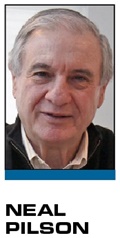During my 40 years in the sports television business, it’s safe to say I have attended many more unnecessary and badly run meetings than meetings that were productive and well-managed. My experience is not unique.
When you are planning your next meeting, here’s a handy list of items to consider before deciding a meeting is even necessary. And once that decision has been made, here’s how to stage and manage the session.
1. Do you really need to call the meeting? As a recent New York Times article reminds us, “Time is a commodity. And time spent at a meeting should generate a return on investment.”
Can you achieve the same outcome by making certain decisions yourself or with a phone call to a trusted colleague? Would an email requesting comments or suggestions be just as productive? If you are planning that time-honored weekly staff meeting, why not make it biweekly or perhaps every month?
2. You have decided a meeting is necessary. Ask yourself, what’s the purpose of the meeting? What result do you want to achieve? What’s the primary reason you are asking people to gather and invest their valuable time and energy?
Spend a few moments to narrow and identify the focus for the session. Prepare an agenda of items you want discussed and resolved. It’s usually helpful to distribute the agenda in advance of the meeting but, occasionally, issues of confidentiality require that the agenda be withheld until the meeting takes place.
3. Consider your invitation list. Less is almost always best for efficiency and ease of decision-making but inclusion of staffers is a good management tool, so the occasional “all hands” gathering can be important. Remember that most meetings are not “teaching” tools; they are primarily a means to reaching a consensus and making decisions on how to run the enterprise.
4. When you have your subject matter and invitation list, send out the notice of meeting and identify the date, time and place with an RSVP protocol. This may seem obvious, but select your meeting location based on the number of people you expect to join you. I have been to too many small rooms where people have to stand and to too many large rooms where unless the participants cluster in a small corner, they can’t hear each other.
5. Decide who will chair the meeting. It’s not always the senior person but it should be someone with good skills in following the agenda, managing time and leading the discussion.
6. If an electronic presentation is desired, always get there early and test the system. Be sure the conference phone is working. Is the lighting adequate? If you are serving refreshments, are they in place? If you are inviting outside people, are their names listed with security?
7. If the meeting is a negotiation or adversarial in nature, choose to sit with your back to the windows for two reasons: You won’t be distracted by the world passing by outside, and (I apologize for this tip) looking into strong light over the course of the day is fatiguing. Why shouldn’t the other guys be subjected to that?
8. The chair should welcome, explain the format and protocol, establish any time constraints, reference the agenda and manage the process. A good chair can run a tough meeting; a bad chair often can’t run easy meetings.
9. This may seem self-evident, but work hard to discuss and resolve the issues that were the reasons for the meeting to be called in the first place.
10. The next point is absolutely critical to the success of the meeting: a discussion of next steps. Before the meeting concludes, the chairman must address and the participants should agree on how to proceed from here. Establish who has the responsibility to follow through and to implement the decisions that have been reached. Set dates for responses and follow-through reporting. Far too many meetings dissolve without a clear understanding of who has responsibility for next steps and how the results of the meeting will be implemented.
11. If desired, draft a short summary of the meeting, including decisions made and follow-up assignments, and distribute to the participants. Also nice to include a thank-you for attending.
12. Make your own diary entries when you expect responses so you are reminded to follow up as necessary.
Meetings can be (a) of great value or (b) a waste of time. Make sure your next meeting falls in category (a).
Neal Pilson (nealhp.@aol.com) is president and founder of Pilson Communications and former president of CBS Sports.




